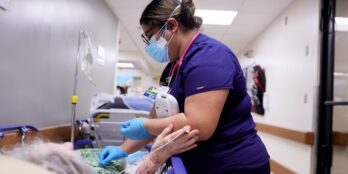
What Long-Term Care Community Data Teaches Us About Fighting Covid-19
 3 min
3 min
Impacts from the COVID-19 pandemic were deadly for the long-term care community. According to a recent study, more than 200,000 long-term care facility residents and staff died from COVID. That represents 23% of all COVID-related deaths in the U.S. These staggering statistics represent the importance of protecting vulnerable populations and their caregivers. COVID-19 is still circulating and remains a challenge for this community. Due to the high number of immuno-compromised residents, residents with multiple comorbidities, and high transmissibility of the virus, COVID-19 as well as other respiratory viruses in a long-term care setting remain a threat to health and safety.
What is COVID?
The World Health Organization defines COVID-19 (or coronavirus disease) as an infectious disease caused by the SARS-CoV-2 virus. The virus spreads through particulates (respiratory droplets or smaller aerosols) from an infected person’s mouth or nose when they cough, sneeze, speak, sing or breathe.
While most people infected only experience mild to moderate symptoms, some become very sick and require medical attention. Older people and those with underlying medical conditions are more likely to become seriously ill.
Why Does COVID Pose a Significant Risk to the Aging Population?
COVID poses the highest risk to infants and the aging population because of the decreased ability of their immune systems to fight off the disease. In addition, as people age comorbidities occur more often. Conditions such as diabetes, obesity, heart disease, and a weakened immune system due to age can limit the body’s response to COVID.
Aging populations in long-term care facilities are at an even greater risk due to the highly social aspect of these facilities. Community dwelling and high transmissibility of viruses result in rapid spread and thereby dramatically impacts the burden of care.
Why is it Important to Study COVID in Long-Term Care Residents?
The number of seniors using long-term care and skilled nursing facilities is expected to increase more than 107% by the year 2050. To help them remain healthy, assess potential new therapies, and to maximize the best outcome, it’s more important than ever to understand ways to treat this population, For example, the average resident of a long-term care facility takes seven medications. The PointClickCare Life Sciences’ data set can provide valuable insights to help researchers, medical professionals, and long-term care staff understand how previous COVID diagnoses or COVID vaccines impacted daily activities, interacted with other medications, and what types of side effects were present.
In order to provide a roadmap for preventative healthcare or the best treatment plans for those already diagnosed, the highest quality data is needed to empower better decisions and insights. While claims data can provide general information on patient disease type and age, it has limited useful data for what is required to analyze outcomes. With electronic health records data like that provided by PointClickCare Life Sciences, you have the ability to examine granular data such as patients’ daily weights, vitals, activities, and dietary information. Whether it’s to guide quality improvement initiatives, identify opportunities for preventative interventions, or to support evidence-based decision-making to enhance overall health outcomes of seniors in long-term care, we’re here to help.
November 7, 2023






